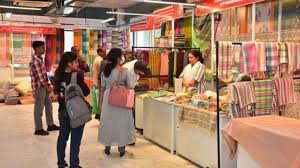Today’s Current Affairs: 7th August 2024 for UPSC IAS exams, State PSC exams, SSC CGL, State SSC, RRB, Railways, Banking Exam & IBPS, etc
Table of Contents
C-130J Super Hercules:

A Bangladesh-registered C-130J Hercules jet became the most tracked flight on Flightradar24.com amid reports of Bangladesh PM Sheikh Hasina quitting and leaving her country.
- C-130J Super Hercules is a four-engine turboprop military transport aircraft.
- It is the US Air Force’s principal tactical cargo and personnel transport aircraft.
- It was developed by Lockheed Martin, a US security and aerospace company.
- The C-130J is the newest generation of the C-130 Hercules, which primarily performs the tactical portion of the airlift mission.
- The aircraft is capable of operating from rough, dirt strips and is the prime transport for airdropping troops and equipment into hostile areas.
- The largest operators are the US Air Force,US Marine Corps, Australia, Canada, India, Italy and the United Kingdom.
- It has reduced crew requirements. A minimal crew of three men is required to operate this aircraft, including two pilots and one loadmaster.
- It has a payload capacity of 19 tons.
- It is powered by four Rolls-Royce AE 2100D3 turboprop engines.
- It has digital avionics, including a Head-Up Display (HUD) for each pilot.
Indian Siris:

A pall of gloom descended on Kumaradevam gram panchayat, located in the East Godavari district, after the death of the century-old Indian siris tree.
- Indian Siris, also known as Albizia lebbeck, is a tropical tree native to India and Southeast Asia.
- It belongs to the Fabaceae family and is a deciduous tree with a wide range of uses.
- They require a warm and humid climate and can be grown in a variety of soil types, including clay, loam, and sandy soil.
- It grows up to a maximum height of 15-20 meters and has a wide-spreading, umbrella-shaped canopy.
- The tree trunk is typically straight, with a diameter of up to 1 meter.
- Its leaves are green and fern-like and can grow up to 25 cm long.
- It has a moderate to dense branching pattern, with branches that spread outwards and upwards from the trunk.
- It produces small, white and fragrant flowers in clusters.
- The tree is capable of fixing nitrogen from the atmosphere, which helps to enrich the soil and support other plant species.
- The extensive, shallow root system makes it a good soil binder and suited to soil conservation and erosion control.
Global Alliance For Improved Nutrition:

A recent report by the Global Alliance for Improved Nutrition (GAIN) calls for nutrition investments in the agri-food sector, which it argues, can reduce gender inequalities, increase productivity, and enhance business resilience.
- Global Alliance for Improved Nutrition (GAIN) eis a Swiss-based foundation launched at the United Nations in 2002 to tackle the human suffering caused by malnutrition.
- Headquartered in Geneva, Switzerland, GAIN has offices in countries with high levels of malnutrition.
- Working with governments, businesses, and civil society, GAIN aims at making healthier food choices more affordable, more available, and more desirable.
- GAIN’s purpose is to improve nutrition outcomes by improving the consumption of nutritious and safe food for all people, especially the most vulnerable.
- It mobilizes public-private partnerships and provides financial and technical support to deliver nutritious foods to those people most at risk of malnutrition.
- The organization also supports improved maternal and infant health by promoting breastfeeding and specialised products for infants over six months and young children.
- In addition, they partner with local businesses to improve the quality of food along agricultural value chains.
- GAIN-supported nutrition programs are reaching an estimated 667 million vulnerable people in more than 30 countries.
Dark Patterns:

Recent research reveals that mobile apps often use deceptive design tactics, known as dark patterns, to manipulate users into unintended actions.
- Dark patterns are deceptive and manipulative user interface (UI) design techniquesemployed by websites, apps, and other digital platforms to trick or manipulate users into taking actions they may not intend to take or to make decisions that are not in their best interest.
- It is a deceptive practice employed to influence user behaviour in a way that benefits the company implementing it.
- The term “dark patterns” was coined in 2010 by Harry Brignull, a user experience specialist.
These patterns are often used to encourage users to sign up for services, make purchases, or share personal information, - among other things.
- Dark patterns exploit cognitive biases and psychological principles to influence user behavior.
- They can range from subtle and mildly misleading to overtly aggressive tactics.
- There are different kinds of dark patterns: Friend spam, forced continuity, disguised ads, confirm shaming, bait and switch, hidden costs, roach motel, privacy zuckering, misdirection, price comparison prevention, trick questions and sneak into basket.
- For Example: ‘Confirm shaming’ means using a phrase, video, audio, or any other means to create a sense of fear, shame, ridicule, or guilt in the mind of the user so as to nudge the user to act in a certain way.
- In November 2023, the Department of Consumer Affairs, Government of India, released guidelines for 13 dark patterns.
- According to these guidelines, the use of any of these prescribed dark patterns amounts to a misleading advertisement, an unfair trade practice, or a violation of consumer rights.
VIRAASAT:

“VIRAASAT”, a fortnight long exhibition dedicated to celebrating the 10th National Handloom Day began at Handloom Haat in Janpath recently.
- VIRAASAT is organized by the National Handloom Development Corporation Ltd (NHDC) under the Ministry of Textiles.
- The series “VIRAASAT”- the “Exclusive Handloom Expo” is a continuation of celebrations held during the previous year around the National Handloom Day.
- The event focuses on the glorious tradition of Handloom and Handicrafts. It also provides a market connection to the handloom weavers and artisans.
- The unique products such as Banarasi, Jamdani, Baluchari, Madhubani, Kosa, Ikkat, Patola, Tussar Silk, Maheshwari, Moirang Phee, Baluchari, Phulkari, Laheriya, Khandua and Tangaliya will be featured in this exhibition.
- The Swadeshi Movement which was launched on 7th August 1905 had encouraged indigenous industries and in particular handloom weavers.
- Since 2015, the Government of India decided to commemorate the 7th of August every year as National Handloom Day.
- The first National Handloom Day was held on 7th August 2015 in Chennai.
- It aims to recognise the efforts and skills of the community of weavers engaged in this sector.
Commemorative Stamps:

The Department of Posts released a set of commemorative postage stamps to celebrate the Paris Olympics.
- Commemorative stamps are issued commemorating important events, prominent personalities in various fields, aspects of nature, beautiful or rare flora and fauna, environmental issues, agricultural activities, national/international issues, games etc.
- These stamps are only available at Philatelic Bureaux and counters or under the Philatelic Deposit Account Scheme.
- They are printed in limited quantities.
- Some of the rules for issuing Commemorative Postage Stamps
- Proposals for the issue of Commemorative Postage Stamps may be sent by any citizen of India.
- Stamps shall be issued only on the apex institution/organization, on its 100th /125th /150th anniversary and not on the branches of any institution or organization.
- The institution/organization should have national or international stature with significant and well-recognised contributions in their respective fields.
- No stamp will be issued on a living personality. The personalities on whom the commemorative postage stamp may be issued should be of national or international importance.
- The occasion to be commemorated must be the birth centenary or 10th /25th /50th /100th death anniversary. Stamps can be issued no sooner than ten years after an individual’s death.
- Exception in this regard will however be considered to be made for personality from the field of Art, Culture and Music.
- A stamp on the building, monument etc. may be issued on its centenary/125th anniversary/150th anniversary etc. The building, to be so honoured must be a Heritage site of national/international importance or a site recognized by ASI of national/international importance.
- These are released by the Department of Posts, Ministry of Communications.
Miombo Forest:

The United Nations Food and Agriculture Organization (FAO) and the Italian Agency for Development Cooperation (AICS) have signed two agreements for the implementation of projects aimed at protecting the Miombo forest.
- The Miombo is a biome that includes tropical and subtropical grasslands, bushlands and savannahs.
- It is a vast African dryland forest ecosystem covering close to 2.7 million square kilometres across southern Africa, including Angola, the Democratic Republic of the Congo, Malawi, Mozambique, Tanzania, Zambia and Zimbabwe.
- The woodlands are characterized by the dominance of Brachystegia species, either alone or in association with Julbernardia and Isoberlinia species.
- It also encompasses four bio-regions and is responsible for maintaining the Greater Zambezi, one of the most important transnational river basins.
- It is facilitating trade in the border region between Mozambique and Zimbabwe.
- This forest is vital for millions of people in rural areas, providing essential resources such as firewood, food, and water
World Development Report 2024 :World Bank Report

A recent World Bank report titled “World Development Report 2024: The Middle Income Trap” has highlighted significant challenges faced by over 100 countries, including India, in achieving high-income status in the coming decades.
Highlights of the World Development Report 2024:
- India is among 100 countries, including China, at risk of falling into the “middle income trap,” where countries struggle to transition from middle-income to high-income status.
- India is at a crucial juncture, benefiting from favorable demographics and advancements in digitalization, but faces a tougher external environment compared to the past.
- India’s aim to become a developed nation by 2047 requires a comprehensive approach that enhances overall economic performance, rather than focusing on isolated sectors.
- The report notes that only 34 middle-income economies have transitioned to high-income status since 1990, often due to special circumstances like European Union integration or oil reserves.
- Middle-income countries face challenges in sustaining economic growth due to diminishing returns on physical capital.
- While low-income countries benefit from building physical capital and improving basic education like India in the 1980s, where capital deepening was crucial, middle-income countries encounter diminishing returns as they invest further.
- Simply increasing saving and investment rates to meet growth targets isn’t sufficient; these countries also need to address factors beyond physical capital.
- Despite having relatively high capital endowments, middle-income economies struggle with productivity issues, highlighting that physical capital alone isn’t the main barrier to further growth.
- The World Bank criticizes many middle-income countries for using outdated economic strategies focused mainly on expanding investment.
- Middle-income countries are home to six billion people, representing 75% of the global population, and generate over 40% of global Gross Domestic Product (GDP).
- The success or failure of these countries in achieving high-income status will significantly impact global economic prosperity
- India is identified as the fastest growing major economy, but it would take 75 years for its per capita income to reach a quarter of the US income levels if current trends continue.
- China would take over 10 years, Indonesia nearly 70 years, and India 75 years to reach a quarter of US income per capita.
Methylocucumis oryzae:

Researchers have isolated and described India’s first cultures of indigenous methanotroph Methylocucumis oryzae from rice fields and wetlands, mainly from Western India.
- Methylocucumis oryzae is a natural bacterium that is abundant in wetlands and rice fields.
- It had a characteristic oval and elongated shape, similar to that of a cucumber, and hence the name ‘methane-eating cucumbers’ was given to this novel genus.
- It is found to be an important methanotroph components.
- It has a remarkably large size compared to other bacteria and is equal to the size of a small yeast (3-6 µm).
- Another unique feature of this bacterium is that it has a strict mesophilic nature and cannot grow above 37ºC while most of the other methanotrophs can tolerate or grow at 37ºC or even at 40ºC.
- The bacterium forms light pale pink colored colonies, and the genome is indicative of a carotenoid pathway.
- In recent years, this methanotroph was also found to promote the growth of rice plants by inducing early flowering and increased grain yield.
- The current constraints with Methylocucumis are slow growth which limits the growth of this culture on a larger scale, needed for mitigation and biotechnological applications.
NOTTO Annual Report 2023-24:

The National Organ and Tissue Transplant Organisation (NOTTO) released its annual report for the year 2023-24 on Indian Organ Donation Day (IODD) on August 3, 2024.
- According to NOTTO, in 2023, India reached a significant milestone by surpassing 1,000 deceased organ donors in a single year for the first time, breaking the record set in 2022.
Highlights of the Report:
Finding Details:
- Gender Distribution of Donors
- 63% of living donors were women.
- 77% of deceased donors were men.
- Transplants by Region
- Delhi-NCR: Nearly 78% of foreign national transplants.
- Delhi: 4,426 transplants total, with foreign nationals accounting for over 32%.
- Rajasthan: 116 transplants to foreign nationals.
- West Bengal: 88 transplants to foreign nationals.
- Deceased Donor Milestone
- More than 1,000 deceased organ donors in a single year for the first time.
- Deceased-donor transplants increased from 837 in 2013 to 2,935 in 2023.
- Transplants with Organs from Unrelated Deceased Donors
- Nine transplants to foreigners with organs from unrelated deceased donors.
- Locations: Three in Tamil Nadu, two each in Delhi, Maharashtra, and Gujarat.
- Foreigners’ Allocation Rule
- Organs from deceased donors are allocated to foreigners only when no matching Indian patients are available.
- Organ Donation Rate
- Less than 1 per million population.
Srinagar Added In World Craft City List:

Srinagar has recently been added to the World Craft Cities list by the World Crafts Council (WCC), recognizing its rich craft traditions making it the fourth such city
from India.
- Jaipur, Malappuram, and Mysore are other three Indian cities on the list included in a total of 60 cities worldwide.
- Srinagar, with a history of about 1,500 years, was a key Silk Route hub for arts, crafts, and trade.
- Notable crafts include Paper-Machie, walnut wood carving, carpets, Sozni embroidery, and Pashmina and Kani shawls.
- The city is known globally for the ‘Cashmere’ brand and paisley motif.
- Crafts such as Zanjan and Filigree were introduced by Iranian artisans five centuries ago.
- Srinagar’s carpet tradition began in the late 14th century with Sufi Saint Sayyid Ali Hamdani.
- In 2021, it was recognized as a UNESCO Creative City for crafts and folk arts.
World Craft City Programme (WCC):
- It was introduced in 2014 by the World Crafts Council AISBL (WCC-International) to honour the crucial contributions of local authorities, craftspeople, and communities
to global craft development.




